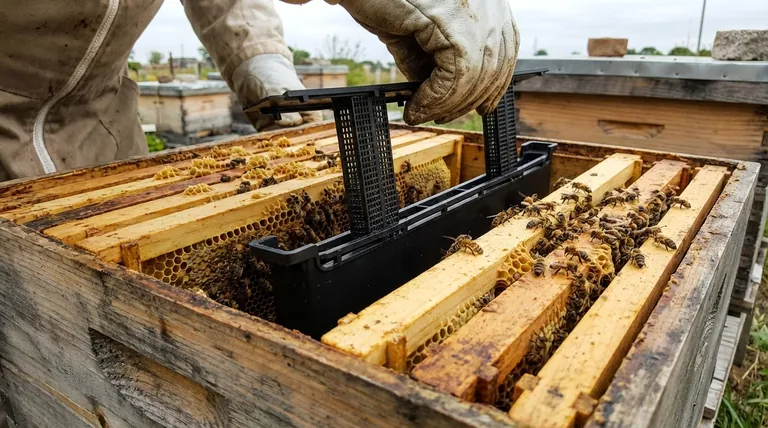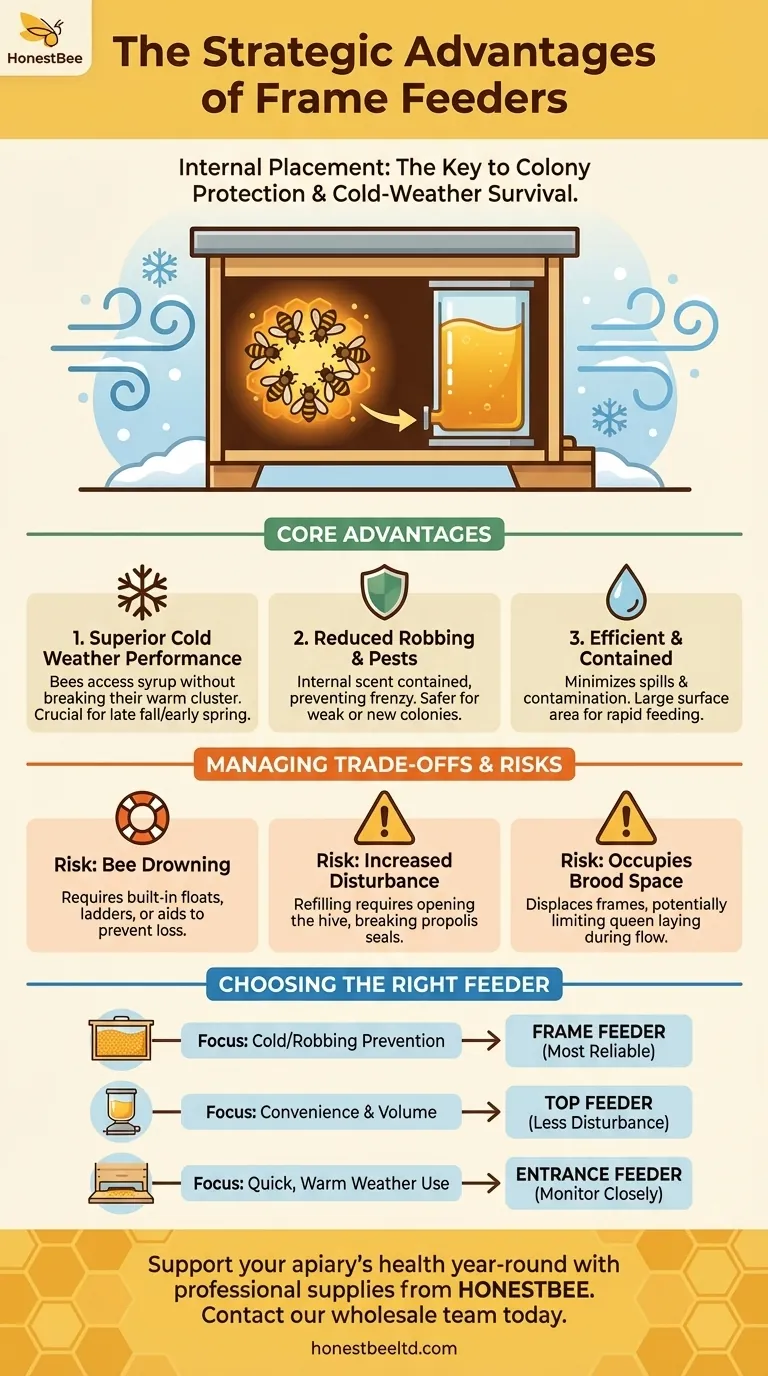In short, frame feeders are advantageous because they are placed inside the hive. This internal placement makes them the superior choice for feeding bees during colder weather, as the colony can access the syrup without breaking their warm cluster. It also significantly reduces the risk of robbing by other bees or pests, providing a secure and contained food source precisely when the colony is most vulnerable.
The core value of a frame feeder is its ability to provide a protected, internal food source. This makes it ideal for supporting a colony during critical periods like late fall and early spring, when external threats and cold temperatures make other feeding methods less effective or even dangerous.

The Core Advantages of In-Hive Feeding
A frame feeder, also known as a division board feeder, replaces one or two frames within the hive body. This simple design principle is the source of its key benefits.
Advantage 1: Superior Cold Weather Performance
Bees form a tight cluster to generate and conserve heat when temperatures drop. Leaving this cluster to access an external feeder can be fatal.
A frame feeder sits directly adjacent to the brood nest, allowing bees to move from the cluster to the food source without being exposed to the cold outside air. This makes it an essential tool for late fall or early spring feeding when nights are still cold.
Advantage 2: Reduced Robbing and Pest Pressure
An open food source is an open invitation. Entrance feeders, in particular, can alert nearby bee colonies, wasps, and ants to a free meal, triggering a "robbing" frenzy that can decimate a weak colony.
Because a frame feeder is entirely inside the hive, its scent is contained. This dramatically lowers the risk of attracting unwanted visitors, making it a much safer option when establishing a new colony or supporting a weaker one.
Advantage 3: Efficient and Contained Feeding
Frame feeders prevent syrup from spilling on the bees or contaminating any in-hive treatments. Their design often includes a large surface area, allowing many bees to feed at once for rapid consumption.
This is especially useful when you need to deliver a large amount of syrup quickly, such as during periods of nectar dearth or inclement weather that prevents foraging.
Understanding the Trade-offs and Risks
No single tool is perfect for every situation. While effective, frame feeders have specific trade-offs that every beekeeper must manage.
The Primary Risk: Bee Drowning
The most significant drawback of a frame feeder is the potential for bees to fall into the syrup and drown. Without a proper mechanism for them to climb out, you can lose a substantial number of bees.
Most modern frame feeders come with built-in floats, ladders, or textured interior walls. If yours does not, you must add a climbing aid, such as a wooden float, or stuff the feeder with dry vegetation to provide a safe platform for the bees.
Increased Hive Disturbance During Refills
To check or refill a frame feeder, you must open the hive. This breaks the propolis seals the bees have made and disturbs the colony.
This contrasts with entrance or top feeders, which can often be monitored and refilled without opening the brood chamber at all. This makes frame feeders less convenient for frequent, routine feeding in warm weather.
Occupies Brood Nest Space
A frame feeder takes up the space of one or two frames. This is space that the queen cannot use to lay eggs and the workers cannot use to store pollen or honey.
During a strong spring nectar flow, this displacement can limit the colony's natural expansion. You must weigh the need for supplemental feeding against the colony's need for space.
How to Choose the Right Feeder for Your Goal
Selecting a feeder isn't about finding the "best" one, but the right one for your specific objective and conditions.
- If your primary focus is cold-weather feeding or preventing robbing: The frame feeder is your most reliable choice due to its protected, in-hive location.
- If your primary focus is maximum convenience and large-volume feeding: A top feeder may be more suitable, as it typically holds more syrup and can be refilled without disturbing the brood nest.
- If your primary focus is quick, small-scale feeding in warm weather: An entrance feeder can work for short-term use, but you must remain vigilant for any signs of robbing.
Understanding these distinct roles empowers you to support your colony's health effectively throughout the year.
Summary Table:
| Advantage | Key Benefit |
|---|---|
| Cold Weather Performance | Bees access food without breaking their warm cluster. |
| Reduced Robbing & Pests | Internal placement contains scent, deterring invaders. |
| Efficient & Contained | Prevents spillage, allows rapid feeding by many bees at once. |
Support your apiary's health year-round with the right equipment from HONESTBEE.
As a trusted supplier for commercial apiaries and beekeeping equipment distributors, we understand that protecting your investment is paramount. Frame feeders are a critical tool for safeguarding colonies during vulnerable periods.
Let HONESTBEE provide your operation with durable, effective beekeeping supplies designed for professional results.
Contact our wholesale team today to discuss your equipment needs and keep your colonies thriving.
Visual Guide

Related Products
- 3.5L Plastic Beehive Frame Feeder Deep Frame Water Feeder for In Hive Use
- Professional Hive Front Entrance Bee Feeder
- Professional In-Hive Frame Bee Feeder by HONESTBEE
- In-Hive Dual Compartment Frame Bee Feeder for Targeted Colony Nutrition
- Boardman Entrance Bee Feeder Durable Galvanized Steel and Wood Construction for Beekeeping
People Also Ask
- Are frame feeders good? Maximize Your Hive's Health with the Right Feeding Strategy
- What are the two most popular types of honey bee feeders? A Guide to Frame and Bucket Feeders
- What is a frame feeder and how does it work? An Efficient In-Hive Feeding Solution
- What are frame feeders, and what are their advantages? Essential for Cold Weather & Efficient Feeding
- What is a frame feeder? A High-Capacity, Secure In-Hive Feeding Solution



















